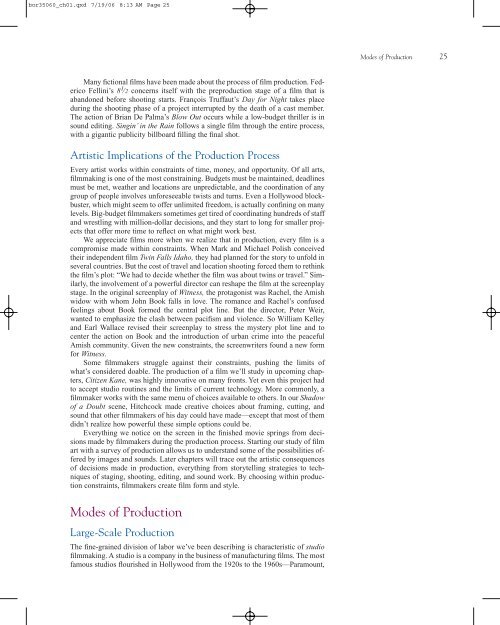FILM ART AND FILMMAKING
FILM ART AND FILMMAKING
FILM ART AND FILMMAKING
Create successful ePaper yourself
Turn your PDF publications into a flip-book with our unique Google optimized e-Paper software.
or35060_ch01.qxd 7/19/06 8:13 AM Page 25<br />
Many fictional films have been made about the process of film production. Federico<br />
Fellini’s 8 1 ⁄ 2 concerns itself with the preproduction stage of a film that is<br />
abandoned before shooting starts. François Truffaut’s Day for Night takes place<br />
during the shooting phase of a project interrupted by the death of a cast member.<br />
The action of Brian De Palma’s Blow Out occurs while a low-budget thriller is in<br />
sound editing. Singin’ in the Rain follows a single film through the entire process,<br />
with a gigantic publicity billboard filling the final shot.<br />
Artistic Implications of the Production Process<br />
Every artist works within constraints of time, money, and opportunity. Of all arts,<br />
filmmaking is one of the most constraining. Budgets must be maintained, deadlines<br />
must be met, weather and locations are unpredictable, and the coordination of any<br />
group of people involves unforeseeable twists and turns. Even a Hollywood blockbuster,<br />
which might seem to offer unlimited freedom, is actually confining on many<br />
levels. Big-budget filmmakers sometimes get tired of coordinating hundreds of staff<br />
and wrestling with million-dollar decisions, and they start to long for smaller projects<br />
that offer more time to reflect on what might work best.<br />
We appreciate films more when we realize that in production, every film is a<br />
compromise made within constraints. When Mark and Michael Polish conceived<br />
their independent film Twin Falls Idaho, they had planned for the story to unfold in<br />
several countries. But the cost of travel and location shooting forced them to rethink<br />
the film’s plot: “We had to decide whether the film was about twins or travel.” Similarly,<br />
the involvement of a powerful director can reshape the film at the screenplay<br />
stage. In the original screenplay of Witness, the protagonist was Rachel, the Amish<br />
widow with whom John Book falls in love. The romance and Rachel’s confused<br />
feelings about Book formed the central plot line. But the director, Peter Weir,<br />
wanted to emphasize the clash between pacifism and violence. So William Kelley<br />
and Earl Wallace revised their screenplay to stress the mystery plot line and to<br />
center the action on Book and the introduction of urban crime into the peaceful<br />
Amish community. Given the new constraints, the screenwriters found a new form<br />
for Witness.<br />
Some filmmakers struggle against their constraints, pushing the limits of<br />
what’s considered doable. The production of a film we’ll study in upcoming chapters,<br />
Citizen Kane, was highly innovative on many fronts. Yet even this project had<br />
to accept studio routines and the limits of current technology. More commonly, a<br />
filmmaker works with the same menu of choices available to others. In our Shadow<br />
of a Doubt scene, Hitchcock made creative choices about framing, cutting, and<br />
sound that other filmmakers of his day could have made—except that most of them<br />
didn’t realize how powerful these simple options could be.<br />
Everything we notice on the screen in the finished movie springs from decisions<br />
made by filmmakers during the production process. Starting our study of film<br />
art with a survey of production allows us to understand some of the possibilities offered<br />
by images and sounds. Later chapters will trace out the artistic consequences<br />
of decisions made in production, everything from storytelling strategies to techniques<br />
of staging, shooting, editing, and sound work. By choosing within production<br />
constraints, filmmakers create film form and style.<br />
Modes of Production<br />
Large-Scale Production<br />
The fine-grained division of labor we’ve been describing is characteristic of studio<br />
filmmaking. A studio is a company in the business of manufacturing films. The most<br />
famous studios flourished in Hollywood from the 1920s to the 1960s—Paramount,<br />
Modes of Production 25

















